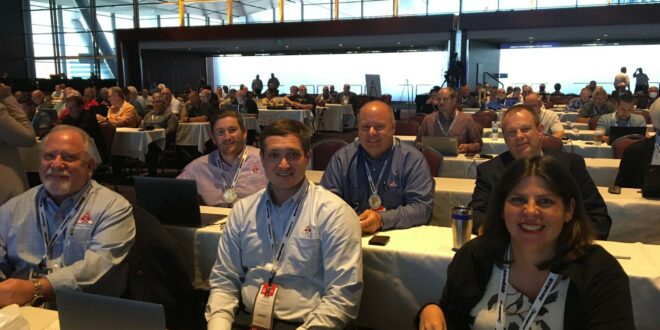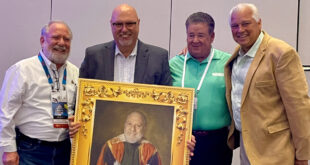
Higher Standards
It was great to be back at the NFPA Conference & Expo this past June. The return to in-person meetings gave everyone in attendance an opportunity to reconnect with colleagues, attend many informative, educational sessions, and—my favorite—argue and discuss amending motions on the floor at the NFPA Technical Meeting.
In the May/June issue of Sprinkler Age, we published a voting guide for the 2022 NFPA Technical Meeting. In that guide, AFSA’s positions were articulated and presented to our membership and to conference attendees who grabbed a copy from our booth in the expo hall. Those positions led to a great discussion prior to the Technical Meeting, and the sprinkler industry was able to compromise and determine a path forward.
Of the seven Certified Amending Motions (CAMs) submitted for NFPA 25, four passed, and three failed. When a CAM passes, the proposed change is accepted by the general membership of NFPA and sent back to the appropriate NFPA Technical Committee to either accept the membership’s proposed change or return the language back to the last edition of the standard—the last point of consensus. The following summarizes the resulting vote, action, and path forward for three of the CAMs that passed on the floor of the NFPA Technical Meeting.
CAM 25-16 – Concealed Sprinklers
Reject Second Revision No. 2
AFSA Position: OPPOSE
NFPA Vote: PASSED
While AFSA opposed the removal of the requirement to inspect the cover plates of concealed sprinklers, we ultimately conceded that there was no technical substantiation to support the new inspection. In discussions with representatives from the health care member section, the group agreed that over the next three years, members of the health care member section would survey their respective hospitals and other structures to gather the necessary data to make an informed decision on whether to require the cover plates of concealed sprinklers to be inspected every five years.
CAM 25-10 – Nonmetallic Sprinkler Piping
Reject Second Revision No. 4
AFSA Position: OPPOSE
NFPA Vote: PASSED
CAM 25-10 was folded into the negotiations to support CAM 25-16, and the reference to the compatibility of nonmetallic sprinkler piping was ultimately removed from the standard. While AFSA still believes that this is the owner’s responsibility, we feel that we can reason through that requirement using the existing language of NFPA 25 and the installation standards. In NFPA 13, the installing contractor is required to provide all literature and instructions describing proper operation and maintenance requirements for equipment and devices installed on the system to the owner. Since nonmetallic sprinkler pipe is a listed product, there will be special listing requirements for routine maintenance that include compatibility. The owner is still responsible for complying with the manufacturer’s literature, and this action makes it more important than ever that the transfer of these documents is recorded so that the installing contractor can avoid any liability in the future due to an owner not complying with the listing requirements.
CAM 25-17 – Clearance to Storage
Reject an Identifiable Part of Second Revision No. 13
AFSA Position: OPPOSE
NFPA Vote: PASSED
During discussions at the Technical Meeting, it was determined that the annual frequency for the inspection of clearance to storage was arbitrarily added to the table in Chapter 5 Sprinkler Systems. With the removal of the line item in the table, the requirements in Chapter 5 now require the clearance to storage to be maintained at all times. While this is not practical for an inspecting contractor, the lack of an interval precludes this activity from being considered an inspection and will ultimately fall back on the owner—unless specifically contracted to another party. To resolve this conflict, AFSA will submit a public input for the 2026 edition of NFPA 25 to move this requirement to Chapter 4 under “Owner’s Responsibilities,” where it belongs.
Future Revision Cycles
AFSA has been and will continue to be very busy this summer as the revision cycle for the 2023 edition of NFPA 14 finished its second-draft meetings in May, and NFPA 13 begins its input stage with the first-draft meetings scheduled at the end of July. Next year’s Technical Meeting will include NFPA 1, which will be the first edition of that code since the technical committee split into three separate committees. NFPA 3 and NFPA 4 will look to address active and passive fire protection systems and determine which standard has scope over the certain type of system. For NFPA 14, AFSA intends to submit two Notices of Intent to Make a Motion (NITMAMs). Other standards to be covered at next year’s meeting include NFPA 101® Life Safety Code® and NFPA 5000®, Building Construction and Safety Code®.
Remember, the standard development process relies on input from the public, so I would l challenge everyone once again to submit a public input or comment, participate in a task group, apply to a technical committee, or attend a committee meeting.
 ABOUT THE AUTHOR: Kevin Hall, M.Eng., P.E., ET, CWBSP, PMSFPE, is the senior manager of engineering and technical services for the American Fire Sprinkler Association (AFSA). He is a member of, and involved in, several National Fire Protection Association (NFPA) technical committees responsible for developing the model codes and standards including, NFPA 1 Fire Code, NFPA 13/13R/13D Installation of Sprinkler Systems, NFPA 20 Installation of Stationary Fire Pumps for Fire Protection, NFPA 30 Flammable and Combustible Liquids Code, and NFPA 915 Remote Inspections. He also represents AFSA on numerous UL standard technical panels responsible for revising and maintaining the product standards used in the sprinkler industry. He is a registered professional engineer in Delaware and Maryland, NICET III certified in water-based system layout, a Certified Water-Based System Professional (NFPA), and a professional member of the Society of Fire Protection Engineers. He earned his Bachelor of Science and Master of Engineering degrees from the University of Maryland, College Park in fire protection engineering. In 2021, he was recognized as one of SFPE’s “5 Under 35” award recipients. Prior to his association and committee work, he worked for Reliance Fire Protection in Baltimore, Maryland as a project manager overseeing projects of various sizes and complexity for the Contracts Division.
ABOUT THE AUTHOR: Kevin Hall, M.Eng., P.E., ET, CWBSP, PMSFPE, is the senior manager of engineering and technical services for the American Fire Sprinkler Association (AFSA). He is a member of, and involved in, several National Fire Protection Association (NFPA) technical committees responsible for developing the model codes and standards including, NFPA 1 Fire Code, NFPA 13/13R/13D Installation of Sprinkler Systems, NFPA 20 Installation of Stationary Fire Pumps for Fire Protection, NFPA 30 Flammable and Combustible Liquids Code, and NFPA 915 Remote Inspections. He also represents AFSA on numerous UL standard technical panels responsible for revising and maintaining the product standards used in the sprinkler industry. He is a registered professional engineer in Delaware and Maryland, NICET III certified in water-based system layout, a Certified Water-Based System Professional (NFPA), and a professional member of the Society of Fire Protection Engineers. He earned his Bachelor of Science and Master of Engineering degrees from the University of Maryland, College Park in fire protection engineering. In 2021, he was recognized as one of SFPE’s “5 Under 35” award recipients. Prior to his association and committee work, he worked for Reliance Fire Protection in Baltimore, Maryland as a project manager overseeing projects of various sizes and complexity for the Contracts Division.

 Sprinkler Age A Publication of the American Fire Sprinkler Association
Sprinkler Age A Publication of the American Fire Sprinkler Association
